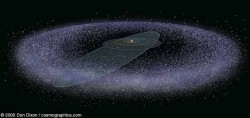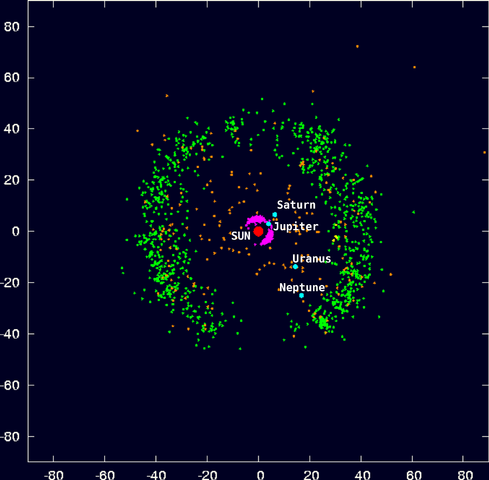The Kuiper belt — the region beyond the orbit of Neptune inhabited by a number of small bodies of rock and ice — hides many clues about the early days of the Solar System. According to the standard picture of Solar System formation, many planetesimals were born in the chaotic region where the giant planets now reside. Some were thrown out beyond the orbit of Neptune, while others stayed put in the form of Trojan asteroids (which orbit in the same trajectory as Jupiter and other planets). This is called the Nice model.
However, not all Kuiper belt objects (KBOs) play nicely with the Nice model.
(I should point out that the model is named named for the city in France and therefore pronounced “neese”.) A new study of large scale surveys of KBOs revealed that those with nearly circular orbits lying roughly in the same plane as the orbits of the major planets don’t fit the Nice model, while those with irregular orbits do. It’s a puzzling anomaly, one with no immediate resolution, but it hints that we need to refine our Solar System formation models.
This new study is described in a recently released paper by Wesley Fraser, Mike Brown, Alessandro Morbidelli, Alex Parker, and Konstantin Baygin (to be published in the Astrophysical Journal, available online). These researchers combined data from seven different surveys of KBOs to determine roughly how many of each size of object are in the Solar System, which in turn is a good gauge of the environment in which they formed.
The difference between this and previous studies is the use of absolute magnitudes — a measure of how bright an object really is — as opposed to their apparent magnitudes, which are simply how bright an object appears. The two types of magnitude are related by the distance an object is from Earth, so the observational challenge comes down to accurate distance measurements. Absolute magnitude is also related to the size of an KBO and its albedo (how much light it reflects), both important physical quantities for understanding formation and composition.
Finding the absolute magnitudes for KBOs is more challenging than apparent magnitudes for obvious reasons: these are small objects, often not resolved as anything other than points of light in a telescope. That means requires measuring the distance to each KBO as accurately as possible. As the authors of the study point out, even small errors in distance measurements can have a large effect on the estimated absolute magnitude.

In terms of orbits, KBOs fall into two categories: “hot” and “cold”, confusing terms having nothing to do with temperature. The “cold” KBOs are those with nearly circular orbits (low eccentricity, in mathematical terms) and low inclinations, meaning their trajectories lie nearly in the ecliptic plane, where the eight canonical planets also orbit. In other words, these objects have nearly planet-like orbits. The “hot” KBOs have elongated orbits and higher inclinations, behavior more akin to comets.
The authors of the new study found that the hot KBOs have the same distribution of sizes as the Trojan asteroids, meaning there are the same relative number of small, medium, and large KBOs and similarly sized Trojans. That hints at a probable common origin in the early days of the Solar System. This is in line with the Nice model, which predicts that, as they migrated into their current orbits, the giant planets kicked many planetesimals out beyond Neptune.
However, the cold KBOs don’t match that pattern at all: there are fewer large KBOs relative to smaller objects. To make matters more strange, both hot and cold seem to follow the same pattern for the smaller bodies, only deviating at larger masses, which is at odds with expectations if the cold KBOs formed where they orbit today.
To put it another way, the Nice model as it stands could explain the hot KBOs and Trojans, but not the cold. That doesn’t mean all is lost, of course. The Nice model seems to do very well except for a few nagging problems, so it’s unlikely that it’s completely wrong. As we’ve learned from studying exoplanet systems, planet formation models are a work in progress — and astronomers are an ingenious lot.


Is there a rough relationship between the Kuiper belt objects albedos and their distance from the sun? I was thinking the farther ones are more likely to retain solid Hydrogen on the surface.
“The “cold” KBOs are those with nearly circular orbits (low eccentricity, in mathematical terms) and low inclinations, meaning their trajectories lie nearly in the ecliptic plane, where the eight canonical planets also orbit. In other words, these objects have nearly planet-like orbits.”
Along with the title, this sentence is misleading in its artificial attempt to preclude dwarf planets from being classed as a subcategory of planets. Kuiper Belt Objects large enough to be in hydrostatic equilibrium are not “planet-like”; they are planets, period, at least according to the geophysical planet definition. Our solar system does not have only eight “canonical planets”; furthermore Mercury orbits at a seven-degree inclination to the ecliptic plane; therefore it should not be lumped with those directly on the ecliptic.
Exoplanet systems, with further study, could provide information crucial to answering the questions this study raises. For example, several multi-planet systems have their planets, usually gas giants, all orbiting in different planes. At least one system has a gas giant more massive and larger than Jupiter in a highly elliptical comet-like orbit. It could be that similar processes during the formation of these solar systems led to some of their planets having eccentric orbits like the “hot” Kuiper Belt planets.
Some of the larger ones are able to retain nitrogen and methane but not hydrogen.
There are some relationships between color and albedo, and also between size and albedo due to nitrogen and methane ices on the largest ones.
The primary problem identified in the paper is not with the Nice model, it has been previously shown that a primordial population of cold KBO’s could survive the instability described by the Nice model.
The problem they identify is that this the standard hierarchical model of planetesimal formation, whereby the large bodies form via the collisions of smaller bodies, which could not form objects as large as those found in the cold classical Kuiper belt at that distance.
There are other models which the large objects form directly from gravel or boulders, however. This one for example describes how the loose binaries found in the cold classical Kuiper belt could be formed: http://arxiv.org/pdf/1007.1465v1.pdf
Are we sure kuiper belt is made up of sun ejecta? Actually asteroid belt is made up of Sun [supernova] ejecta while kuiper belt is mostly made up of interstellar medium. Hot & cold KBOs are the KBO at different developmental stage. Kuiper belt is the factory producing & recycling KBO continuously
my model of solar system formation is based on the dark energy & dark matter consideration
http://swarajgroups.blogspot.in/2013/06/out-of-box-thinking-is-essential-in.html
swarajgroups.blogspot.in
It seems obvious that the hot KBOs formed in the outer solar system and the cold KBOs formed in place like the comets of the Oort cloud. Saying you have a container of salt and sand, where two particles are the same size in the same place, does not mean that salt is sand or vice versa. The Nice model can explain one population and not the other, so it’s not wrong. It’s simply true for the subject of the model.
One looming problem for the Nice model is the little matter of the origin of the angular momentum of the Oort cloud.
With a 5 Earth-mass outer Oort cloud and 10-to-100 times that in the Hills cloud, the the Oort cloud as a whole has far more angular momentum than the inner solar system of the planets and Sun combined which supposedly hurled it out there; therefore the Nice model is kaput. (Where angular momentum is proportional to the square root of the semi-major axes.)
Secondly, the cold classical Kuiper belt is predominantly composed of binary TNOs which may be capable of circularizing their heliocentric orbits at the expense of the angular momentum of their binary orbits, explaining the difference between the hot and cold classical TNOs.